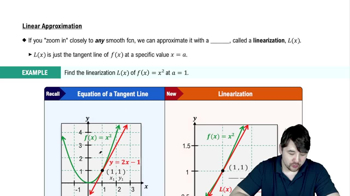Table of contents
- 0. Functions7h 52m
- Introduction to Functions16m
- Piecewise Functions10m
- Properties of Functions9m
- Common Functions1h 8m
- Transformations5m
- Combining Functions27m
- Exponent rules32m
- Exponential Functions28m
- Logarithmic Functions24m
- Properties of Logarithms34m
- Exponential & Logarithmic Equations35m
- Introduction to Trigonometric Functions38m
- Graphs of Trigonometric Functions44m
- Trigonometric Identities47m
- Inverse Trigonometric Functions48m
- 1. Limits and Continuity2h 2m
- 2. Intro to Derivatives1h 33m
- 3. Techniques of Differentiation3h 18m
- 4. Applications of Derivatives2h 38m
- 5. Graphical Applications of Derivatives6h 2m
- 6. Derivatives of Inverse, Exponential, & Logarithmic Functions2h 37m
- 7. Antiderivatives & Indefinite Integrals1h 26m
- 8. Definite Integrals3h 25m
4. Applications of Derivatives
Linearization
Problem 83a
Textbook Question
a. Use the Intermediate Value Theorem to show that the equation has a solution in the given interval.
x=cos x; (0,π/2)
 Verified step by step guidance
Verified step by step guidance1
Define the function f(x) = x - cos(x) and identify the interval (0, π/2).
Evaluate f(0) to find its value: f(0) = 0 - cos(0) = 0 - 1 = -1.
Evaluate f(π/2) to find its value: f(π/2) = π/2 - cos(π/2) = π/2 - 0 = π/2.
Note that f(0) is negative and f(π/2) is positive, indicating a change in sign over the interval (0, π/2).
Apply the Intermediate Value Theorem, which states that since f(x) is continuous on (0, π/2) and changes sign, there exists at least one c in (0, π/2) such that f(c) = 0.
Recommended similar problem, with video answer:
 Verified Solution
Verified SolutionThis video solution was recommended by our tutors as helpful for the problem above
Video duration:
9mPlay a video:
Was this helpful?
Related Videos
Related Practice




